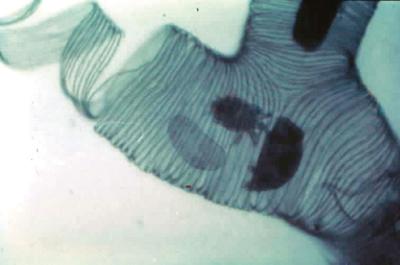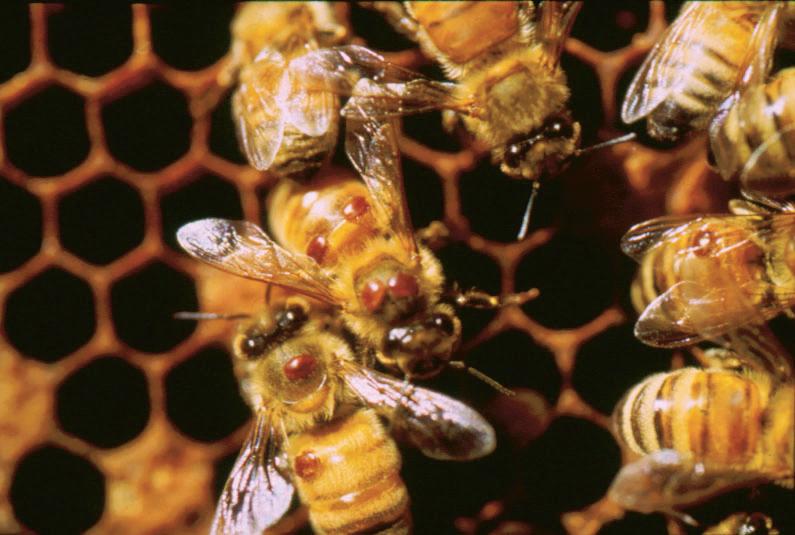The 1980s marked the beginning of a precipitous and ongoing drop in honey bee populations. Two different parasitic mites were inadvertently introduced into the US, both of which live exclusively on honey bees and do not affect other bee populations. One microscopic mite, the tracheal mite Acarapis woodi, lives in the honey bees’ breathing tubes (Figure 2.4), piercing them to feed on the bee’s blood, or hemolymph. If many bees in the colony are infested with tracheal mites, the adult worker force becomes weakened and sometimes dies. But these mites are relatively benign compared to the next mite that was introduced.

Varroa destructor is relatively large and can be seen with the naked eye. Varroa mites have a more complicated lifestyle than tracheal mites. These mites also feed on bee hemolymph on both adults and tender developing pupae. Fertile female mites ride around on the bodies of adult bees, eventually entering a cell containing a larva just ready to pupate. As the bee goes through the pupal phase, the mite and her developing offspring feed on the pupa’s hemolymph. Varroa does not kill the pupa outright, but weakens it. Pupae forced to share their blood and nutrient supply with a family of large mites become short-lived adults with compromised immune systems. The mites prefer to infest drone brood because the mites can produce more offspring in the longer developing drone pupae. However, Varroa has no compunction about infesting worker pupae, and when enough of the colony’s worker force develops from parasitized pupae, the colony becomes weakened and eventually will die (see sidebar).
Controlling the mites has been approached differently, depending on the beekeeper and the mite. Strategies range from ignoring the mites to combating them with chemical treatments. In the US most beekeepers choose the chemical strategy. Chemical control of tracheal mites involves using menthol crystals. The vapors enter the bees’ breathing tubes and kill the mites. Bees don’t really like the intense odor of menthol in their colony, but the treatment seems relatively harmless. Interestingly, with time, most beekeepers have come to ignore tracheal mites, particularly as Varroa has become a more consuming problem. Ignoring tracheal mites allowed the bees time to develop their own defenses against it. Today, many colonies in the US demonstrate some resistance to these mites, and only in some regions is it necessary for beekeepers to continue to use menthol to treat them.
The Varroa Mite
It should seem odd to the alert reader that obligate parasites suchas Varroa mites would eventually kill off their host. After all, they cannot live on anything but honey bees and if they kill the host colony, they will die. But honey bees are maintained in apiaries, with many colonies in close proximity, and it is easy for mites to jump ship on a foraging bee and enter a neighboring colony and continue on. This movement of mites is called horizontal transmission and is the main mode of transmission of Varroa mites throughout the country. Fortunately, there are some locations, such as the Arnot forest in upstate New York, that host a small number of feral colonies spaced far enough apart in tree cavities that the mites cannot jump ship with ease. In this situation, the mites and bees have reached a tenuous equilibrium; the bees are weakened but the colonies do not die. The bees grow and eventually swarm, and this is how the mite gains access to new territory. This process of transmission of mites from mother to daughter colony is called vertical transmission, and it is a more sustainable situation for the bees and the mites. However, to pollinate large-scale crops, we need many, many colonies in one area, which inevitably and unfortunately leads to extreme horizontal transmission.
Controlling Varroa is a different issue. It is not easy to ignore this creature. The size of a Varroa mite on a bee is relatively the same size as a dinner plate on a person (Figure 2.5). Imagine having a mite on you that size! To keep colonies alive beekeepers have taken steps most never dreamed of: They became pesticide applicators. This is unusual because beekeepers are environmentalists by necessity. The health of their bees depends on a healthy environment. Beekeepers tend to be staunch opponents of reckless pesticide use on crops, especially compounds that potentially harm their foraging bees. But to keep producing honey and to provide healthy bees for pollination, they needed to control Varroa. Chemical companies and researchers rushed to the “rescue” and so began the insidious chemical treadmill process within honey bee colonies. The treadmill began with the registration of one compound, a synthetic pyrethroid, that was highly effective in controlling Varroa mites, and was followed by the development of resistance to the pyrethroid by the mite, so that a new compound from a different class of insecticides had to be registered, and so on. The honey bee industry is relatively small and not a profitable market to large chemical companies, so only one compound was registered for the first ten years, which did not allow beekeepers to rotate chemicals and forestall resistance by the mites to the compounds.
We cannot blame the US beekeepers for turning to chemical control methods to keep their colonies alive. Their option was to let their colonies die and not fulfill pollination contracts. If honey bee populations were allowed to crash from the mites, what would happen to the 615,000 acres (~250,000 hectares) of almond trees in California that require bee pollination all at once? Or 1,000 acres (~400 hectares) of blueberries in Maine? Or, 100 acres (~40 hectares) of apples in Washington, or even 50 acres (~20 hectares) of pumpkins in Minnesota? The simple fact is that the American public would not have tolerated a reduced crop of bee-pollinated fruits and vegetables for the ten to twenty years it would have taken for the honey bee population to naturally evolve defenses against the mites and build up to pre-mite population levels. It was in the immediate interests of most people to keep our fruits and vegetables pollinated by honey bees so we could continue to purchase inexpensive, well-formed, and succulent produce.

What happens to the diseases and parasites of bees when so many colonies are placed in such high densities, such as in apiaries, or moved en masse by trucks and placed in holding yards until the crop is ready to bloom? The magnitude of the potential problem is astounding. We produce fruits and vegetables on a large scale, but the demand it places on honey bees is historically unprecedented and unsustainable. Honey bees are the pollination workhorse, and our agricultural practices force them to work themselves down to the nubbin.
Even if we did not grow such expansive acreages of fruits and vegetables that require bee pollination, another pressing question must be addressed: Are there sufficient wildflowers in our environment for bees to feed on? As we cover native wildflowers and weedy fields with lawns in the process of urban sprawl, and as we spray our highways and roadsides with herbicides to kill weeds, we diminish bee pasture. Bees thrive on flowers that we consider unkept and weedy. Just like humans, bees absolutely require a variety of amino acids from protein, which they obtain from a wide variety of flowers to maintain a balanced and healthy diet. A half-million acres (~200,000 hectares) of almond blossoms sounds like a lot of pollen and protein. But for bees, it is like eating nothing but chicken every day for a month.
